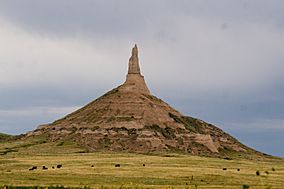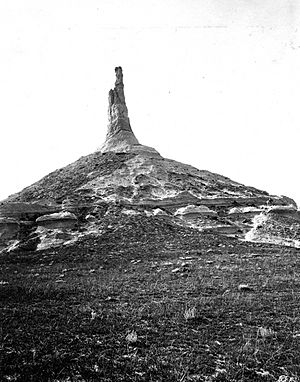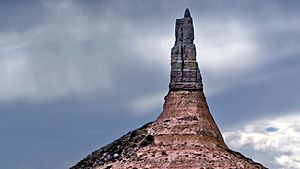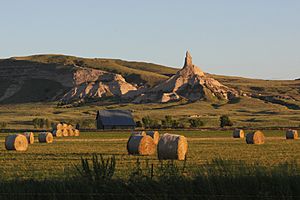Chimney Rock National Historic Site facts for kids
Quick facts for kids Chimney Rock National Historic Site |
|
|---|---|

Chimney Rock (2009)
|
|
| Location | Morrill County, Nebraska, U.S. |
| Nearest city | Bayard, Nebraska |
| Area | 83 acres (34 ha) |
| Established | October 15, 1966 |
| Operator | History Nebraska |
Chimney Rock is a famous rock formation in western Nebraska, U.S.. It stands tall in Morrill County. This amazing rock rises over 300 feet (91 meters) above the North Platte River valley. Its highest point is 4,228 feet above sea level.
For many years in the mid-1800s, Chimney Rock was a very important landmark. It guided pioneers traveling west on the Oregon Trail, the California Trail, and the Mormon Trail. These trails were like old highways for people moving across the country. The rock is still a clear landmark today for people driving on U.S. Route 26 and Nebraska Highway 92.
In 1956, Chimney Rock was named a Chimney Rock National Historic Site. It is managed by History Nebraska and works with the National Park Service. The rock was also added to the National Register of Historic Places on October 15, 1966.
Contents
The History of Chimney Rock
Long before European settlers arrived, Native American tribes lived in this area. The Lakota Sioux had their own names for this special rock formation.
The first non-Native people to likely see Chimney Rock were explorers in 1813. These explorers were part of Robert Stuart's group, traveling east from the Pacific Ocean. Many other explorers and travelers wrote about Chimney Rock in their journals after this first sighting.
The name "Chimney Rock" probably came from early fur traders. The first time the name "Chimney Rock" was written down was in 1827 by Joshua Pilcher. Before it became officially known as Chimney Rock, people called it by other names. Some of these names included Chimley Rock and Chimney Tower.
There was once a small town called Chimney Rock near the base of the formation. It even had a post office from 1913 to 1922.
Old drawings, paintings, and written stories show that Chimney Rock used to be taller. Over time, it has become shorter due to natural forces. Things like erosion (when wind and water wear away rock) and lightning strikes have changed its shape. Some stories even say that cannon fire from the ground and aircraft also played a part.
How Chimney Rock Was Formed
Chimney Rock is mostly made of a type of clay called Brule clay. This clay is mixed with layers of volcanic ash and a type of rock called Arikaree sandstone. The harder sandstone layers at the top have protected the rock. This protection helped the pillar stay standing after it broke away from a larger cliff long ago. Chimney Rock rises about 286 feet (87 meters) from the ground around it.
Visiting Chimney Rock Today
Chimney Rock became a National Historic Site on August 9, 1956. It is managed by History Nebraska with help from the National Park Service. Chimney Rock is one of the most famous landmarks along the historic Oregon Trail. Another well-known landmark on the trail is Independence Rock in Wyoming.
You can find Chimney Rock about 20 miles southeast of Scotts Bluff National Monument. It is located right on Nebraska Highway 92.
If you visit, you can stop at the Ethel and Christopher J. Abbot Visitor Center. This center has museum exhibits and a video. These show what life was like for the pioneers and how they traveled west. There is also a gift shop where you can find souvenirs.
On March 1, 2006, the state of Nebraska released its special State Quarter. This quarter features a covered wagon traveling west past Chimney Rock. It celebrates Nebraska's important role in the westward movement of people.
See also






